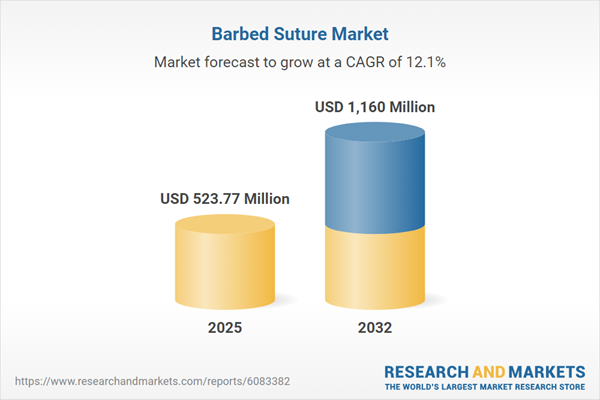Speak directly to the analyst to clarify any post sales queries you may have.
As surgical techniques advance, the barbed suture market is navigating increased demand and regulatory transformation, creating strategic opportunities for senior leaders in surgical wound closure solutions.
Barbed Suture Market Snapshot
The barbed suture market expanded from USD 466.02 million in 2024 to USD 523.77 million in 2025, and it is projected to attain USD 1.16 billion by 2032, reflecting a CAGR of 12.12%. This robust growth is largely driven by the widespread clinical adoption of knotless sutures, which enhance tension distribution and streamline closure procedures. Surgeons increasingly select barbed sutures to optimize efficiency, reduce overall operative time, and improve patient recovery, while the adoption of robotic and minimally invasive surgery accelerates specialized demand. These systems deliver procedural flexibility and compatibility with emerging surgical platforms, positioning barbed sutures as integral to next-generation operating environments.
Scope & Segmentation
This report delivers a clear breakdown of the barbed suture market, defining each segment that impacts commercial and clinical strategy for healthcare organizations and manufacturers globally:
- Application Areas: Covering cardiac, thoracic, general surgery, gynecological, orthopedic, reconstructive, and urological cases, each with distinct clinical protocols and varying market penetration.
- Procedure Types: Encompassing both minimally invasive methods and traditional open surgeries, shaping requirements for suture selection, workflow integration, and adaptability to surgical technique.
- Product Types: Including absorbable and nonabsorbable barbed sutures, facilitating choices based on healing timelines, infection prevention, and structural durability.
- Material Types: Analyzing the use of key polymer options such as polydioxanone, polyglactin 910, polyglycolic acid, and polypropylene, each engineered for optimal absorption and resilience.
- End Use Settings: Segmenting hospitals, ambulatory surgical centers, and clinics by complexity, required resources, and patient volumes, informing supply and procurement models.
- Distribution Channels: Exploring hospital pharmacies, e-commerce platforms, medical supply outlets, and wholesale distributors, which illustrate the diversity of regional purchasing preferences and logistical considerations.
- Geographical Coverage: Detailing the Americas, Europe, Middle East & Africa, and Asia-Pacific, with insights at country and sub-regional levels to support tailored strategic planning.
Beneath these core segments is a foundation of technological progress, regulatory harmonization, and polymer development, driving diversification and broadening adoption worldwide.
Key Takeaways
- The increasing use of minimally invasive and robotic techniques highlights the need for barbed sutures that can deliver precision and consistency in complex wound closure procedures.
- Procurement dynamics and adoption rates differ regionally; the Americas benefit from established reimbursement approaches, while Asia-Pacific sees growth in day surgery volume influencing purchasing strategy.
- Innovation in polymers and antimicrobial coatings strengthens product biocompatibility and handling safety while addressing infection control standards.
- Resilient supply chains—achieved through collaborative raw material sourcing and strong distributor partnerships—are essential to consistent delivery and continuity amid global market challenges.
- Market participants leverage digital enhancements and integrated systems, improving ease of use and supporting multi-disciplinary surgical teams in increasingly complex environments.
- Shifting regulatory requirements and enhanced clinical validation are extending product development timelines and calling for strategic regulatory planning and compliance monitoring.
Tariff Impact
Proposed United States tariffs in 2025 may substantially influence manufacturing cost structures for the barbed suture market. Duties on imported polymers and intermediates are likely to raise production expenses, which could lead to revised pricing models or renegotiated contract terms for providers. These pressures may also encourage relocation of manufacturing to domestic sites and highlight the necessity for robust supply chain resilience. Consequently, healthcare purchasers may tighten procurement criteria and foster increased competition among suppliers, with long-term effects on both contract compliance and broader market operations.
Methodology & Data Sources
This analysis utilizes a mixed-method approach, combining comprehensive industry literature reviews, regulatory filing analysis, and structured interviews with clinicians, senior procurement professionals, and executives. Data integrity is reinforced through quantitative validation from supplier shipments, purchasing records, and distributor feedback. Supply and regulatory chain mapping provides a full-spectrum overview of the industry landscape.
Why This Report Matters
- Senior leaders gain actionable guidance for product portfolio optimization and investment alignment in growth segments of the surgical closure market.
- Clear visibility into evolving compliance mandates, regional procurement differences, and technology trends supports informed competitive positioning and risk mitigation.
- Access to segmented market intelligence enables proactive management of regulatory and supply chain disruption, fostering stronger margin performance and operational clarity.
Conclusion
The barbed suture market will continue to evolve as technology, regulation, and procurement approaches transform. Detailed segmentation and strategic intelligence empower decision-makers to mitigate risk, enhance value creation, and capture emerging opportunities across the surgical closure landscape.
Table of Contents
3. Executive Summary
4. Market Overview
7. Cumulative Impact of Artificial Intelligence 2025
Companies Mentioned
The companies profiled in this Barbed Suture market report include:- Medtronic plc
- Ethicon, Inc.
- B. Braun Melsungen AG
- ConMed Corporation
- Becton, Dickinson and Company
- Integra LifeSciences Holdings Corporation
- AngioDynamics, Inc.
- Teleflex Incorporated
Table Information
| Report Attribute | Details |
|---|---|
| No. of Pages | 180 |
| Published | October 2025 |
| Forecast Period | 2025 - 2032 |
| Estimated Market Value ( USD | $ 523.77 Million |
| Forecasted Market Value ( USD | $ 1160 Million |
| Compound Annual Growth Rate | 12.1% |
| Regions Covered | Global |
| No. of Companies Mentioned | 9 |









